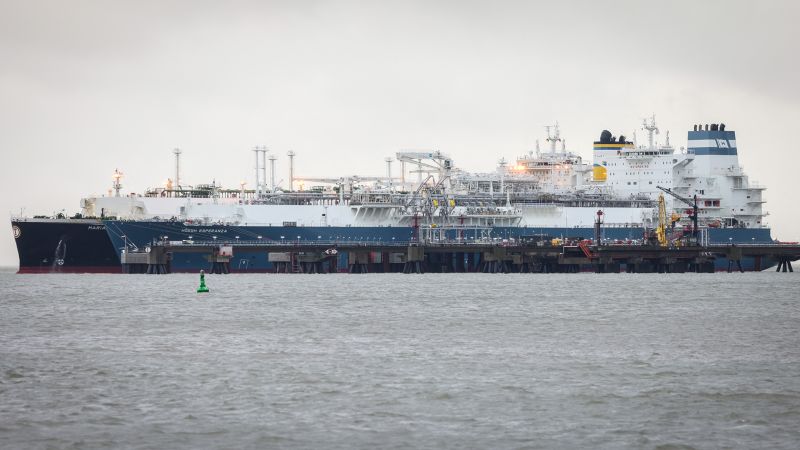Tech
Europe’s stunning high-tech luxury train
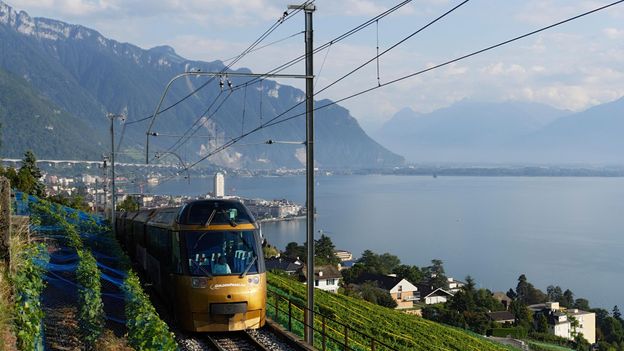
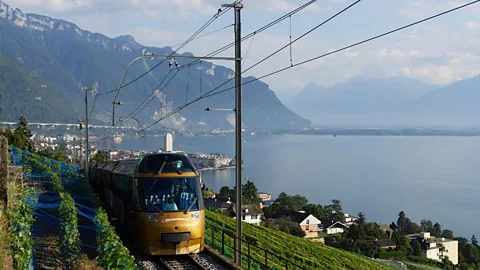 Alamy
AlamyTracing a medieval trade route through the Swiss Alps and valleys, the GoldenPass Express isn’t just one of the world’s most scenic train rides; it’s an engineering marvel.
As I sink into the plush, cream-coloured leather recliner, a glass of Champagne in hand and hiking boots raised, I’m ready for a three-hour spectacle where nature takes centre stage. But the stage isn’t just in front of me – it’s all around.
I’m not in a theatre; I’m in Switzerland aboard the GoldenPass Express: a state-of-the-art panoramic train where floor-to-ceiling windows reveal stunning views of the Swiss countryside – from turquoise lakes that mirror towering mountain peaks to rolling meadows dotted with storybook chalets – that rival the grandest cinematic experiences. Sitting in the nine-seat Prestige Class carriage in a specially designed heated, swivelling chair feels both private and personal – as if I’ve got the snowcapped Alps, wildflower-laced pastures and bell-adorned cows to myself.
Rail Journeys is a BBC Travel series that celebrates the world’s most interesting train rides and inspires readers to travel overland.
Opened in December 2022 and fully relaunched in June 2023 after addressing problems with track wear, The GoldenPass Express (GPX) is one of Europe’s newest (and most luxurious) high-tech trains. Its 115km journey follows a medieval trade route connecting Interlaken‘s glaciers to Montreux‘s terraced vineyards, and thanks to a technological innovation, the GPX allows travellers to take one of the world’s most scenic train routes without transferring, as passengers did previously.
The GPX is one of five premium panoramic trains within the Swiss Travel System. Individual tickets range from 56-145 Swiss francs (roughly £50-130). It’s also included in the Swiss Travel Pass (starting from 244 Swiss francs – roughly £219 – and children under 16 ride free of charge) which offers unlimited access to all public transportation (trains, trams, buses and passenger ferries), 50% off mountain railways and gondolas, and free admission to more than 500 museums.
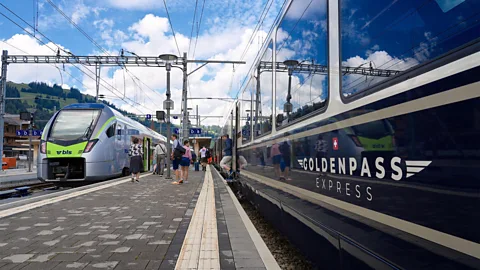 Alamy
AlamyThe train’s midnight-blue exterior and classic design evoke the bygone era of the original Orient Express that still connects Paris to Istanbul. Inside, the interior is crisp and cutting-edge, the Prestige Class specially designed chairs are by Ferrari-designer firm Pininfarina and are the only such rail seats in Europe. Need lower back support? There’s a button for that. Tired feet? Elevate your legs. Feeling chilly? Just press the seat warmer. Want a different view? Simply pivot your seat to face the direction of your choice. Just don’t fall asleep!
But what truly sets the GPX apart from other luxury trains is something you can’t see: it can seamlessly jump between tracks of different gauges and voltages.
Built by Montreux-Oberland-Bernois Railway (MOB) in collaboration with BLS AG (BLS) in Bern, the train winds its way down from the heights of the Bernese Alps, passing the luxurious town of Gstaad, beloved by A-listers for its exclusivity and isolation, and Château d’Oex, famous for its hot air balloon festival (25 January-2 February 2025), before snaking through vineyards as it makes its dramatic descent towards the Vaudois Riviera. Finally, it reaches sun-soaked Montreux, where palms sway on the glistening shores of Lake Geneva.
In 1905, when MOB set out to build the GoldenPass line, the aim was to connect Francophone Montreux to German-speaking Interlaken – two big touristic and economic hubs – with a single trainline. But somewhere along the way, MOB noticed the rail wasn’t the same width; the gauges varied. It took 120 years to find a system bridging the gap.
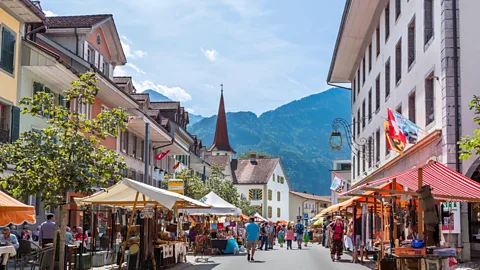 Alamy
AlamyThe world’s railroads use a patchwork of varying gauges – mainly broad, standard and narrow. Railway development lacked industry standards in the 19th Century, leading to varied gauges to suit terrain, transport purpose and political influences. This is one of the main reasons why we often need to change trains when we’re travelling.
As Trains magazine senior editor David Lassen tells the BBC, “countries slow to settle on a single gauge paid the price with operating challenges”. Case in point: Switzerland.
The idea of directly connecting Lake Geneva to Lakes Thun and Brienz in Interlaken dates to the late 1800s. Since 1916, the Lucerne-Interlaken-Zweisimmen-Montreux route, known as the GoldenPass line, allowed travel between these destinations, but required two train changes because of the tracks’ differing gauges. In 1928, the concept of adding a third rail was discussed.
“That would have required building tunnels,” said MOB product manager Fanny Moix. She explained that this was “technically impossible” because of a combination of bureaucracy and the complexity of building dual-gauge tracks through a busy, complicated junction.
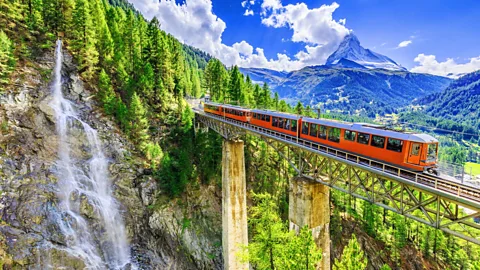 Alamy
AlamyStill, as Interlaken Tourism markets manager Celina Finger maintains: “Changing trains is a huge hassle for tourists.” It’s also a reason why the GoldenPass line hasn’t been as popular as its panoramic counterparts, like the Glacier Express.
Now, instead of requiring travellers to change trains in the middle of the journey, the GPX can make the three-hour-15-minute journey directly, thanks to the revolutionary “variable gauge bogie”. The technology, developed in 2022 after 15 years of research and costing 89m Swiss francs (£80m), was publicly funded by the cantons of Vaud, Bern, Freiburg and the Swiss Confederation. This innovation facilitates seamless transitions between narrow and standard gauges and voltage changes within seconds, effectively enabling a train to jump tracks while moving. It’s a groundbreaking new standard in rail travel – not just in Switzerland, but globally.
“[The GPX] is a link to our past and our future,” said Frédéric Delachaux, MOB marketing director, explaining that it realises the centuries-old dream of linking Switzerland to Europe by rail via the Alps.
As I made the historic journey for the first time, approaching Zweisimmen station, I hesitated to leave the comforts of my warm seat where I was nibbling on local cheeses (there is no full-service dining on board but there are local snack options). I stretched my legs and peered out the window as we briefly paused for the locomotive change, which allows the train to adapt to the electrical voltage change. A few minutes later, we were travelling towards Schönried, a ski resort town neighbouring Gstaad, and as the train carried on, I barely felt a thing.
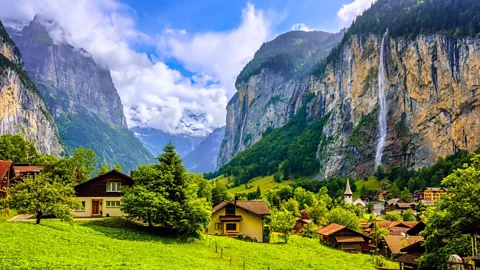 Getty Images
Getty ImagesMeanwhile, as the train’s elevation shifted ever so slightly (rising about 200 mm) to accommodate the gauge attrition and platform height, an engineering marvel was happening right below my feet – even if only a discerning train aficionado would notice it.
“It’s a big frustration for us in marketing because you don’t feel anything!” lamented Delachaux. Perhaps the engineers did too good a job. Because of this, the gauge change is displayed on a screen to passengers as it’s happening.
While there are other trains in France and Japan that can move a few centimetres, “this is the only train in the world that moves 43cm”, said Delachaux.
It’s perhaps no surprise that the Swiss were able to pull off this engineering feat. Living in a landlocked nation that’s 70% mountainous and filled with some 1,500 lakes, people here have long had to negotiate the obstacles posed by their challenging terrain – and along the way, exemplified a certain determination and ingenuity that is decidedly Swiss.
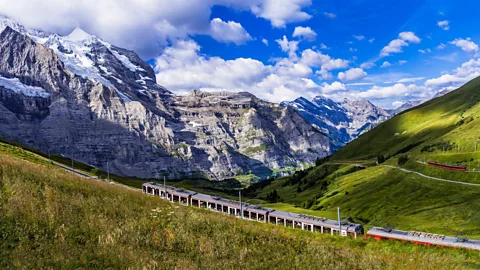 Getty Images
Getty ImagesAs Clarence Rook wrote in his 1907 book Switzerland and Its People: “There are bigger mountains in the world than may be found in Switzerland. But you will nowhere find in so small a space so many triumphs of engineering. The Swiss roads and railways stand as a monument to the victory of human skill over physical obstacles.”
And so, I wondered, are there plans to connect the entire GoldenPass line from its origin at Lucerne to Montreux?
“That’s the new dream,” said Moix, laughing. “It’s also a technical issue because between Lucerne and Interlaken we have a cog railway. That means we’d need to add a cog system to the GoldenPass Express, and that takes a lot of time – another lifetime.”








